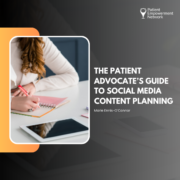The Patient Advocate’s Guide to Social Media Content Planning
In our role as patient advocates, social media is an important tool that we use for sharing information, connecting with others, and amplifying our voices. Managing social media effectively can be challenging in and of itself, but it can be even more challenging when you are undergoing cancer treatment. To minimize your workload, content planning is key.
In this article, we will explore why social media content planning is a valuable strategy and how to do it effectively.
Why You Should Plan Your Social Media Content In Advance
Creates Consistency:
Content planning allows you to maintain a consistent presence on social media. Consistency builds trust and makes your advocacy efforts more visible.
Algorithm Visibility:
Social media algorithms love content that engages users consistently. By keeping a consistent schedule and planning your posts in advance, you’ll get more visibility from the algorithms.
Proactive Advocacy:
By planning your content, you position yourself as a proactive advocate. By getting ahead of key moments, awareness campaigns, and significant dates, you can amplify your advocacy message rather than reacting haphazardly.
Enhances Collaboration:
When working with other advocates on a campaign, content planning keeps everyone on the same page. This simplifies collaboration and ensures a consistent message across all channels.
Alleviates Burnout:
The demands of patient advocacy can be emotionally and mentally taxing, especially when managing health issues. Content planning allows you to allocate specific blocks of time for content creation and scheduling, freeing you from the pressure of daily posting. With a well-thought-out calendar, you can work at your own pace and avoid burnout.
Now that we’ve explored the rationale behind content planning, let’s look at how to implement it effectively.
1. Create a Content Calendar
Creating a content calendar is the foundation of good content planning.
Here are some tips to help you create your content calendar:
Choose a Calendar Format
Choose the format that will work best for you. You can use digital tools like Google Calendar, Microsoft Excel, or specific social media management platforms. Alternatively, a physical planner or whiteboard can work if you prefer a tangible approach.
Set a Time Frame
Determine the time frame your content calendar will cover. Ideally, plan your content at least one month in advance. This allows time for content creation, revisions, and scheduling, reducing last-minute stress.
Identify Key Dates and Events
Note down key dates, events, and awareness months relevant to your advocacy cause. These can include World Health Days, national observances, or local events.
Include a mix of both evergreen content (relevant year-round) and timely content (related to current events or trends).
Plan Content Distribution
Mark on your calendar how you’ll distribute your content across different social media platforms. Each platform may require slightly different content formats and messaging to optimize engagement.
Maintain Flexibility
While a content calendar provides structure and helps you plan ahead, advocacy often revolves around societal, political, and healthcare issues that are subject to rapid change. Emerging issues may require you to pivot your content strategy to address the most pressing matters, ensuring that your advocacy remains relevant and impactful. When creating your content calendar, leave some slots open or designate them as “flexible.” These slots can be used for addressing emergent issues as they arise without disrupting your overall schedule.
2. Allocate A Mix of Content Types
Decide on the types of content you’ll create. You will add more depth and dynamism to your social media advocacy by diversifying your content.
Here are some ideas for a mix of content types you can use:
- Use text-based posts to deliver key takeaways, prompt discussions, or provide brief updates. Craft compelling headlines and captions to capture attention.
- Share impactful images, illustrations, or memes that resonate with your advocacy cause.
- Create video content that highlights personal stories, interviews experts, or explains complex concepts. Pay attention to video quality and subtitles for accessibility.
- Pose questions related to your cause, gather feedback, and involve your audience by using poll features. Share poll results and discuss their implications in follow up posts.
- Curate informative articles that educates your audience about relevant topics, research findings, or treatment options.
3. Plan Posting Frequency
Determine how often you’ll post on each platform. Different social media platforms have varying recommended posting frequencies due to their algorithms and user behaviors. For instance, X’s (formerly known as Twitter) fast-paced nature often requires more frequent updates.
Focus on the quality of your content rather than sheer volume. Posting too frequently with low-quality or repetitive content can lead to audience fatigue and unfollows. It’s always better to offer valuable, relevant content that resonates with your audience.
4. Schedule Posts
The ability to schedule your social media content in advance is a game-changer for effective content planning. You can schedule posts for specific dates and times, ensuring your content goes live when your audience is most active. For advocacy with a global audience, you can schedule posts according to different time zones, ensuring your content reaches a worldwide audience at the right times.
There are many social media management tools, such as Buffer and HootSuite, that support a variety of platforms, including Facebook, Twitter, Instagram, LinkedIn, and others. This multi-platform capability simplifies the task of managing content across different channels. Rather than posting manually at specific times, you can plan and schedule content for multiple platforms all at once.
5. Monitor and Adapt
Continuously monitor the performance of your content calendar. Use analytics to track engagement, reach, and other relevant metrics.
Here are some key metrics to track:
Engagement Metrics:
Likes, shares, comments, and retweets. These indicators reflect how actively your audience is interacting with your content.
Reach and Impressions:
How many people are seeing your content (reach) and how often it’s being displayed (impressions). This data gives you an idea of your content’s visibility.
Click-Through Rates (CTR):
The percentage of people who click on links within your posts. CTR is crucial for tracking conversions, such as website visits or signing up for newsletters.
Armed with these data-driven insights, spend some time analyzing which posts or content types consistently perform well. Understand what elements contribute to their success, and consider creating more content in a similar vein. Conversely, if certain posts or content types consistently underperform, reassess their relevance and value. Are there adjustments you can make to improve their engagement potential?
In summary, dedicating time to strategic content planning transcends good practice; it stands as the cornerstone of your online advocacy. As outlined in this article, taking a systematic approach to your social media content can enhance your advocacy efforts. Follow these steps and incorporate these tips into your online advocacy to achieve even greater success in the future.

A Stanford Medicine X e-Patient scholar, Marie Ennis O’Connor is an internationally recognized keynote speaker, writer, and consultant on global trends in patient engagement, digital health and participatory medicine. Marie’s work is informed by her passion for embedding the patient voice at the heart of healthcare values. She writes about the experience of transitioning from breast cancer patient to advocate on her award-winning blog Journeying Beyond Breast Cancer.










